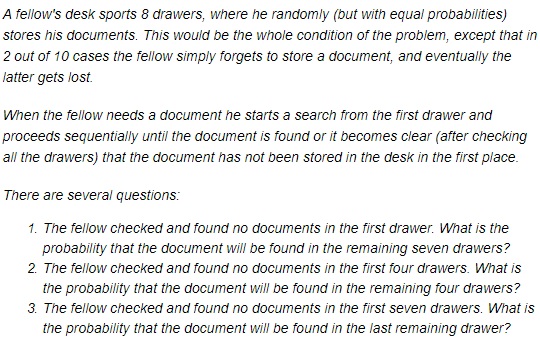Diminishing Hopes
Problem

Answer
The answers to the three questions are $\displaystyle \frac{7}{9},$ $\displaystyle \frac{2}{3}$ and $\displaystyle \frac{1}{3},$ respectively. The result may be surprising. Chances of locating the document decrease with every checked drawer. The general formula for the probability of finding the document after unsuccessfully checking n drawers is $\displaystyle P_{n} = \frac{8 - n}{10 - n}.$ This is a decreasing function of $n$ for $\displaystyle n \lt 10.$ You can check the solutions below.
Solution 1 (Clever)
Let's add two imaginary drawers to the desk and assume that this is where the documents get lost. We may even think of them as being locked during a search.
With $k$ drawers to go, of which two are unavailable, the probability of a successful outcome is $\displaystyle \frac{k - 2}{k}.$ With $\displaystyle k = 10 - n,$ this reduces to $\displaystyle P_{n} = \frac{8 - n}{10 - n}.$ This is a decreasing function of $n$ for $\displaystyle n < 10.$
Another curiosity: if we only ask about the probability of finding the document in the next available drawer (after checking the first $n$ drawers), the probability will be $\displaystyle Q_{n} = \frac{1}{10 - n},$ an increasing function of $n$ for $\displaystyle n < 10.$
Solution 2 (Counting odds)
Not finding it after $k$ checks is $\displaystyle \frac{8}{8-k}$ times more likely if not in desk (not find with probability $1),$ vs. in desk (not find with probability $\displaystyle \frac{8-k}{8}).$ Prior odds not in the desk are $1:4.$ So posterior odds not in desk are $\displaystyle \frac{8}{8-k}:4,$ i.e. $2:(8-k)$ so odds in favor are $(8-k):2,$ i.e. (1) $7:2,$ (2) $4:2,$ (3) $1:2,$ which translates into the probabilities (1) $\displaystyle \frac{7}{9},$ (2) $\displaystyle \frac{4}{6},$ (3) $\displaystyle \frac{1}{3}.$
Solution 3 (Conditional probabilities)
Let us denote thevent "document lost" by $L$ and "document is in drawer $i$" by $D_i.$ Let the unconditional probability of $D_i$ be $q,$ $\displaystyle q=\frac{1}{8}\cdot\frac{4}{5}=\frac{1}{10}.$ The overbar below designates a complementary event. Then
$\displaystyle P(\overline{L}|\overline{D_1})=\frac{P(\overline{D_1}|\overline{L})}{P(\overline{D_1})}=\frac{(7/8)(8q)}{1-q}=\frac{7}{9}.$
$\displaystyle P(\overline{L}|\cap_{i=1}^4\overline{D_i})=\frac{\displaystyle P(\cup_{i=1}^4\overline{D_i}|\overline{L})}{\displaystyle P(\cup_{i=1}^4D_i)}=\frac{(1/2)(8q)}{1-4q}=\frac{2}{3}.$
$\displaystyle P(\overline{L}|\cap_{i=1}^7\overline{D_i})=\frac{\displaystyle P(\cup_{i=1}^7\overline{D_i}|\overline{L})}{\displaystyle P(\cup_{i=1}^7D_i)}=\frac{(1/8)(8q)}{1-7q}=\frac{1}{3}.$
Solution 4 (Bayesian odds)
We assume that the search for a document is thorough enough to ensure that a document that was stored in the desk will be necessarily found.
Let $D$ denote the event that the sought document is in one of the drawers, $!D$ that is is not: $\displaystyle P(D)=\frac{4}{5},$ $\displaystyle P(!D)=\frac{1}{5}.$ Let $K$ be the event of not finding the document in the first $k$ drawers. Then, computing the Bayesian odds:
$\displaystyle \frac{P(!D|K)}{P(D|K)}=\frac{P(K|!D)}{P(K|D)}\cdot\frac{P(!D)}{P(D)},$
where $\displaystyle \frac{P(!D)}{P(D)}=\frac{1}{4},$ $P(K|!D)=1,$ $P(K|D)$ is the probability of the document not being found in the first $k$ drawers, even though it is somewhere in the desk. This exactly means that the document is in the $8-k$ remaining drawers, making $\displaystyle P(K|D)=\frac{8-k}{8}.$ Thus,
$\displaystyle \frac{P(!D|K)}{P(D|K)}=\frac{8}{8-k}\cdot\frac{1}{4}=\frac{2}{8-k}.$
Since $P(!D|K)+P(D|K)=1,$ the above resolves into $\displaystyle P(D|K)=\frac{8-k}{10-k}.$
This gives the three answers above.
Solution 5 (Bayes's Theorem)
In the notations of Solution 3,
$\displaystyle \begin{align}P(D|K)a=\frac{P(K|D)\cdot P(D)}{P(K|D)\cdot P(D)+P(K|!D)\cdot P(!D)}=\frac{\displaystyle \frac{8-k}{8}\cdot\frac{4}{5}}{\displaystyle \frac{8-k}{8}\cdot\frac{4}{5}+1\cdot\frac{1}{5}}\\ a=\frac{\displaystyle \frac{8-k}{2}}{\displaystyle \frac{8-k+2}{2}}=\frac{8-k}{10-k}. \end{align}$
Acknowledgment
The problem and Solution 1 came from Ruma Falk's book Understanding Probability and Statistics (A K Peters, 1993). Michael Wiener's solution coincided with Solution 1; Solution 2 is by Joshua B. Miller; Solution 3 is by Amit Itagi.
|Contact| |Front page| |Contents| |Probability|
Copyright © 1996-2018 Alexander Bogomolny
73599421
